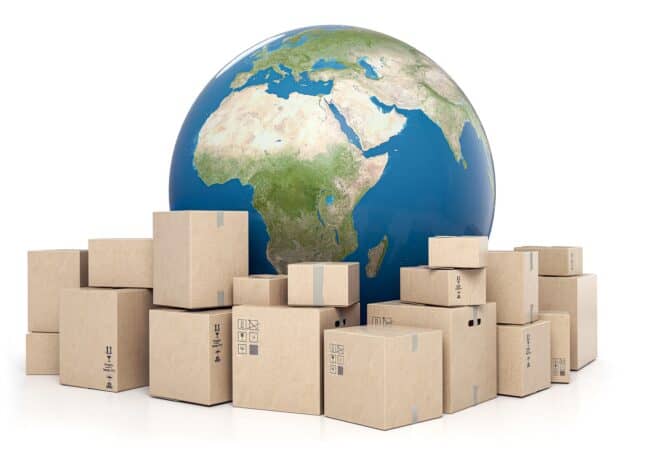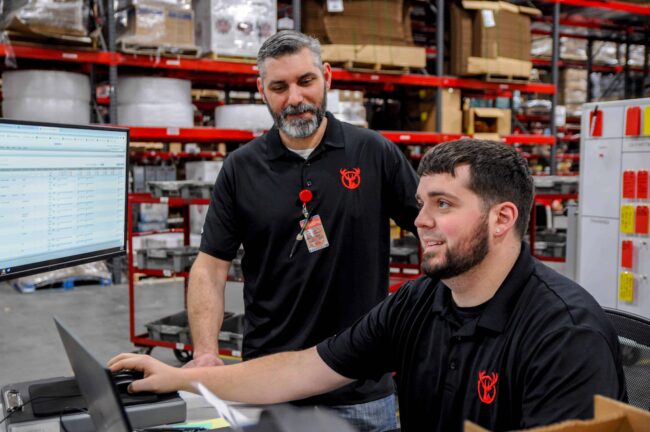Supply Chain Management (SCM) is a career choice that is exploding due to ongoing demands in the fulfillment and logistics space. From COVID-19 increasing eCommerce sales to most supply chains going global, the industry needs more professionals like you. Georgetown University projects that SCM employment will grow 6.75% over the next 10 years (2022-2031), making it a wise option for your future too.
We know that you’ll find hundreds of courses, certificates, and programs around supply chain management online. Think supply chain management is for you? Then, it is crucial to understand what it is, why it’s important, and how to start down the career path. Here’s our guide to help you with becoming an SCM professional.
This post was originally published in September 2016. It was updated on May 4th, 2021, to reflect current trends, data, and the fact that supply chain management is still a growing career field around the globe.
Six common questions on supply chain basics
1. What exactly is the supply chain?
The supply chain is made up of the following five primary stages, each starting with an “S”:
- Strategizing: A plan to determine how to deliver your products to consumers efficiently and cost-effectively.
- Sourcing: Decide which suppliers will provide the goods and services you require to create, store and ship your products.
- Supplying: This is where you supply your product by making it, testing it, and packaging it for shipping.
- Sending: This is the logistics phase that includes warehousing, picking, packing, shipping, and invoicing.
- Supporting: This is where you address problems, such as defective products, and where good customer service plays a significant role.
2. What is supply chain software?
The types of supply chain software vary widely, depending on the supply chain phase they work with, but most companies need software to help with logistics, supply, and manufacturing status. There is a mix of options, including some tools branded directly as SCM software. Many vendors combine some parts of the five stages, but few do not cover every element because software needs differ among products and customers.
Remember, one essential element of any supply chain tool is the ability to share data with suppliers and other chain partners.
3. What does supply chain collaboration mean?
Here, collaboration means communicating and sharing data between suppliers and manufacturers, manufacturers and retailers, and other connections in the chain. It helps supply chain processes run smoothly and saves on inventory and management costs.
For example, sharing data via supply chain software can alert a supplier when a plant is low on raw materials. Manufacturers can be alerted when their retail customers are running low on inventory. Plus, collaboration can automate these messages and actions like restocking, as well as invoicing and payments.
4. What does the term “extended supply chain” mean?
The extended supply chain includes every entity that contributes to creating, storing, and shipping a product. Supply chain managers need to know each link in the chain to know where to fix the problem if one link breaks. For example, a magazine can’t be mailed out to subscribers if the paper mill doesn’t deliver to the printer.
5. How has the globalization of the supply chain affected the business world?
A global supply chain may be complex due to long distances and exchange rates, but modern innovations, technologies, and software have made it far more sufficient. An SCM degree helps you learn proper controls to maximize the benefit of globalization. These include:
- Saving money on supplies
- Reducing storage costs
- Providing opportunities to enter new markets
- Enabling 24/7 service due to varying time zones
- Raising the standard of living in developing countries
- And improving collaboration so business owners can exchange ideas and learn from each other
6. What new technologies are coming out that will affect the supply chain?
Logistics was often considered a slow industry to evolve. While it previously lagged in adopting new technologies, the past decade has been ripe with significant advancements. Sensors and RFID tagging have standardized many transportation services, providing more data that is easier to manage than traditional barcodes. Automation and robotics are simplifying warehouse management and improving order accuracy and tracking across the entire supply chain. The adoption of the Internet of Things (IoT) and Big Data have pushed the supply chain into a more mobile, connected grid where every partner has the information necessary to keep things running along problem-free.
Blockchain is currently being looked at as the “next big thing” in the supply chain space. What’s interesting here is that the tech is exciting enough to get partners from around the world to collaborate, even though most supply chain use cases simply mirror existing database solutions.
Understanding supply chain complexities
According to the Council of Supply Chain Management Professionals (CSCMP), the supply chain encompasses all the steps that manufacturers, retailers, distributors, and other companies take to produce and deliver products to consumers. All these entities work together to complete the design, production, and delivery of services and products for customers to buy.
The supply chain enables producers to give customers what they want, when they want it, and at a reasonable cost. The supply chain network includes:
- Vendors: Produce and provides raw materials.
- Producers: Transform raw materials into products.
- Warehouses: Store raw materials and products.
- Distribution centers: Collect and delivers products.
- Retailers: Offers products to consumers via online or brick-and-mortar stores.
Supply chains are why the producer can provide customers with what they need, when and where they need it, at the price they want.
Why the buzz?
The many benefits of supply chain management
SCM professionals work to provide products to people faster and more efficiently, and at a lower cost. The cooperation of SCMs working together can lower the cost of items by making the raw materials easier and less costly to access. For this reason, most companies require the assistance of well-training SCM professionals, and according to the CSCMP, businesses like Toyota, Dell, Proctor & Gamble, Nokia, and Wal-Mart all attribute their overall success to SCM.
1. Improved customer service
SCM can improve customer service by focusing on a product’s:
- Availability: Consumers look for a variety of offerings in any quantities they desire.
- Location: Customers want products to be there when they need them, such as when a repair shop needs computer parts to fix a customer’s PC.
- Support: Consumers expect fast repairs and the quick delivery of replacement products, if necessary.
- Delivery: People expect to get their products on time. Think of a gift that must arrive in time for a friend’s birthday or the two-day shipping you expect when you shop online.
2. Lower operating costs
SCM reduces overall operating costs by:
- Lowering purchase prices: Retailers keep prices low for consumers by not storing, protecting, and ensuring expensive inventory items in large quantities. But, they need them delivered quickly when consumers want them, such as a big-box retailer who needs the latest HDTV delivered to a customer.
- Decreasing total supply chain expenses: SCMs create efficient networks that fulfill customer service objectives at the least expense, helping companies compete better in today’s busy marketplace. According to the CSCMP, one example is Dell building each computer according to what customers ordered, shipping directly to them.
- Keeping production costs in check: Manufacturing plants count on supply chains to deliver materials on time to prevent the shutdown of a production line due to a lack of materials. The CSCMP reports that an unanticipated delay of a shipment to an automotive assembly plant, for example, can cause a temporary factory closing that can add up to millions of dollars a day in lost wages and a whopping $20,000 each minute in lost revenue.
3. A bigger bottom line
SCM can increase profits by:
- Controlling supply chain costs: Reducing supply chain prices can save companies money and increase profits overall.
- Speeds up cash flow: SCMs can design a supply chain that moves faster, enabling them to bill customers quicker; therefore, they get paid sooner.
- Decreases fixed assets: Supply chain management makes things work efficiently and reduces the need for fixed assets like warehouses, factories, and vehicles. A company can save money if it can cut down on the number of buildings and vehicles required to store and move products while still meeting fulfillment demands.
Supply chain managers provide many benefits to businesses. However, they also help ensure human survival by designing supply networks to help with disaster relief missions, medical emergencies, terrorist attacks, and other types of public disasters. In the U.S., groups like ALAN support recovery thanks to professionals donating their time and companies donating supplies and equipment.
Stepping stones
The supply chain management career path
Those interested in supply chain management can follow several career paths depending on their talents and interests. They can also choose the type, location, size, and structure of a particular company they want to work for and the various departments within a particular company. SCMs can choose from nearly all industries and types of employers, from consulting firms and logistics services to manufacturers and retailers.
The SCM mindset
To be successful as an SCM, you should aim to:
- Be a highly efficient decision-maker who takes responsibility for all your actions.
- Gather skills that are transferable to a variety of positions and tasks.
- Become a valuable, cooperative team player that people want to work with often.
- Learn a large number of business skills, including the supply chain process, through education, experience, and hands-on training or internships.
Entry-level supply chain management
First steps on your path to success
SCM program graduates can go for entry-level jobs in logistics or procurement as purchasing, traffic or inventory control analysts, or buyers. Graduates who demonstrate solid managerial skills can climb the ladder to the head of operations, procurement, or logistics for all kinds of manufacturing, medical, service, and retail businesses. A few of the many jobs available to SCM professionals include:
- Buyer: Manages the purchasing of goods and services for a company by working with internal sources, like production, operations, and marketing, and also external sources, like managing contracts and relationships with outside suppliers.
- Planner or analyst: Assembles and analyzes data using quantitative methodologies to make recommendations and to improve and manage the supply chain process.
- Inventory specialist: Assures inventory accuracy and quality by creating a supply process to keep costs down and improve customer service. Manages the movement and storage of stock. Improves worker productivity and space usage in distribution areas.
- Materials planner, materials analyst: Manages inbound inventory and raw materials by collaborating with internal departments and external suppliers for a more cost-efficient delivery to the production line. Some responsibilities include inbound transporting of materials, scheduling, receiving, and storing.
- Traffic analyst or transportation coordinator: Chooses and monitors transportation carriers for inbound goods. Handles relationships with internal customers and carriers to deliver goods promptly.
- Scheduler, production coordinator, or operations analyst/planner: Coordinates daily production schedules and predicts production needs for the future using statistical process control and predictive analysis.
No matter what they do, almost every business and association will purchase goods, manage inventory, create products, manage consumer relationships, and move supply. So, the opportunities for supply control managers are nearly endless.
Where to look for jobs in SCM
Fresh-faced graduates can look for work in the following areas and industries:
- Retailers and distributors: Retailers and distributors employ SCMs for inventory and transportation cost management and to improve customer service by enhancing in-stock availability.
- Service firms: These firms provide professional services, such as commercial real estate, managing, financing, and executive recruiting. The service firm itself needs SCM expertise to help with internal operations. Service firms target hotels, banks, restaurants, and more.
- Production and manufacturing companies: Manufacturers create many products for sale or resale to private consumers and companies. A laptop manufacturer may supply a large educational institution while also selling laptops to small regional stores. SCM professionals help manage these diverse chains.
- Third-party logistic firms: Third-party logistics (3PL) providers offer various supply chain services to their customers. Non-asset-based 3PLs advise clients on supply chain operations, and some offer warehousing, transportation, and other logistics services.
- Transport company: Transportation companies supply freight delivery services in all modes of transportation. These include water, air, motor, rail, and even via pipeline. Most transportation firms offer intermodal transportation services to their customers. SCMs help move essential components, raw materials, and other items through the supply chain.
- Consulting firms: These firms advise customers who need supply chain management help. They offer information on effective supply chain processes. Some create specialized designs and improvements based on the company’s current supply chain practices.
- Government agencies: Agencies operating at the local, state, or federal level benefit from the management of the supply. SCMs handle the purchasing, storage and distribution of goods. Here, you’ll also ensure agencies meet strict regulatory requirements.
- Universities and educational institutions: Many institutions teach people how to increase their supply chain management expertise. These organizations combine teaching, research, and industry partnerships to increase knowledge, resources, and interest.
And don’t forget us
Supply chain management means looking at the overall supply chain and managing each link. You enable the efficient movement of products, information, and services between suppliers, manufacturers, and customers. At the same time, an SCM must consider the end goal: to increase growth and revenues while reducing costs.
Red Stag Fulfillment is always on the lookout for high-quality logistics, supply chain, and fulfillment talent. If you’re pursuing supply chain management experience or want to learn more about working in the fulfillment space, check out our careers page.









